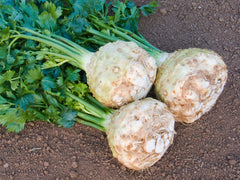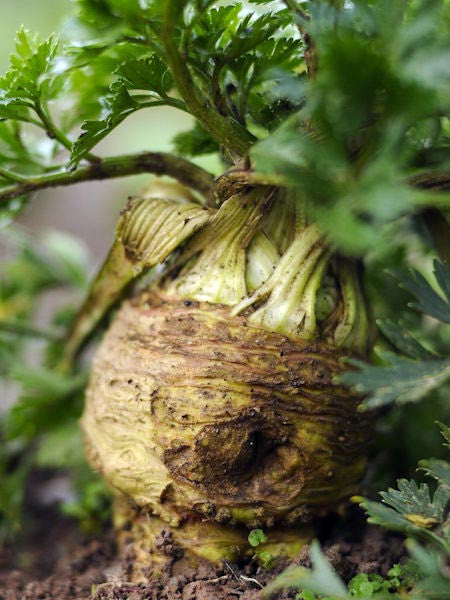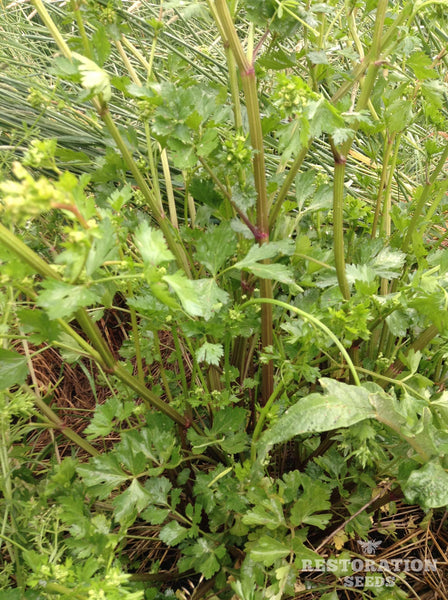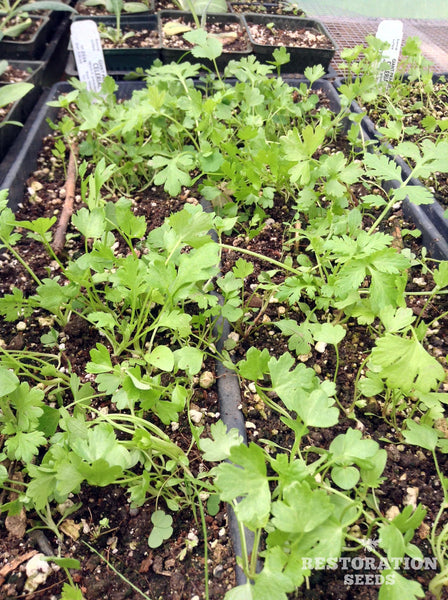Giant Prague
giant-prague-celeriac Giant Prague Apium A. graveolens rapaceum
HOW TO GROW CELERIAC
Start indoors 10–12 weeks before last frost in 4” deep undivided flats or cold frame, plant out 1 week after frost in well tilled friable or sandy soil. For fall harvest, transplant 18 weeks before first frost. Reduce water for 7–10 days to harden off for transplant. Direct sow when soil is above 60˚F. Remove fine and lateral roots, and soil attached to crown for better development. Ensure adequate soil potassium, calcium and water to prevent black heart. Rotate crops to prevent leaf blight. Plant in protected beds to prevent rodent browsing. When working with celeriac on hot sunny days, wear long sleeves and pants, wash exposed skin after contact. Surface sow, press into soil, do not cover. Soil pH 6.1–7.5. Hardiness zones 6. Biennial.
Days from maturity calculated from the date of seeding. Federal germination standard: 55%. Average 63,500 seeds per ounce. Usual seed life: 4–5 years. Isolation distance for seed saving: 3 miles.
Planting Depth surface requires light
Soil Temp. Germ. 70–75˚F
Days to Germ. 14–21
Plant Spacing 9–12in
Row Spacing 24–36”
Days To Maturity 120
Full Sun, Moist Well Drained Soil
Days from maturity calculated from the date of seeding. Federal germination standard: 55%. Average 63,500 seeds per ounce. Usual seed life: 4–5 years. Isolation distance for seed saving: 3 miles.
Planting Depth surface requires light
Soil Temp. Germ. 70–75˚F
Days to Germ. 14–21
Plant Spacing 9–12in
Row Spacing 24–36”
Days To Maturity 120
Full Sun, Moist Well Drained Soil
Giant Prague Seed Count
1 Ounce ≈ 56,700 seeds
- 250 Seeds$3.50
- 2500 Seeds$18.50
This European heritage variety was introduced in 1871. It is a standard cultivar grown for its large white root and relatively smooth skin. It’s easier to grow than its cousin celery, and produces large, firm, smooth roots with white creamy flesh that remains white after blanching. It can be eaten fresh and crisp, a...
This European heritage variety was introduced in 1871. It is a standard cultivar grown for its large white root and relatively smooth skin. It’s easier to grow than its cousin celery, and produces large, firm, smooth roots with white creamy flesh that remains white after blanching. It can be eaten fresh and crisp, and is sometimes served in French cuisine shredded and topped with a mustard mayonnaise sauce. It has the mild flavor of celery and parsley, which makes it delicious in soups, stews, au gratin or pureed with mash potatoes. It’s an ingredient in Waldorf salad with celery, apples and walnuts. High in vitamin C. Also known as turnip-rooted, knob celery or German celery. Tags: Color: White, Shape: Round, Heritage: Heirloom, Season: Spring Fall, Certification: Organic.
Learn More
Reviews




